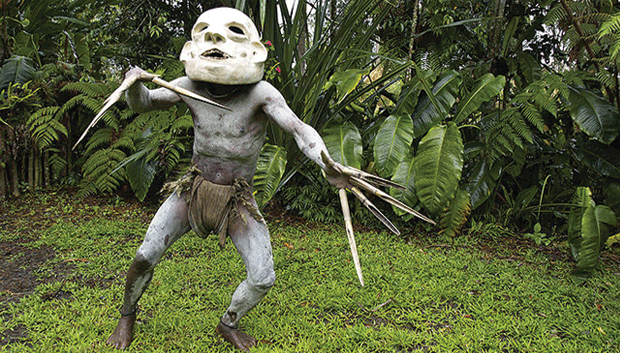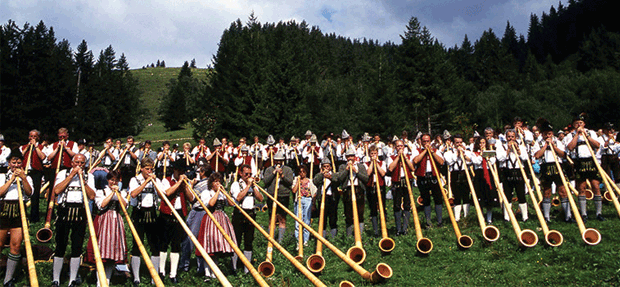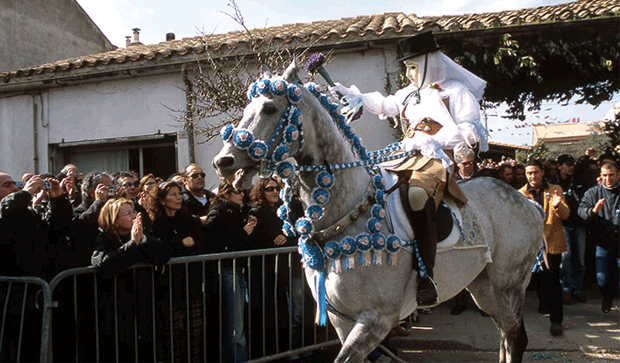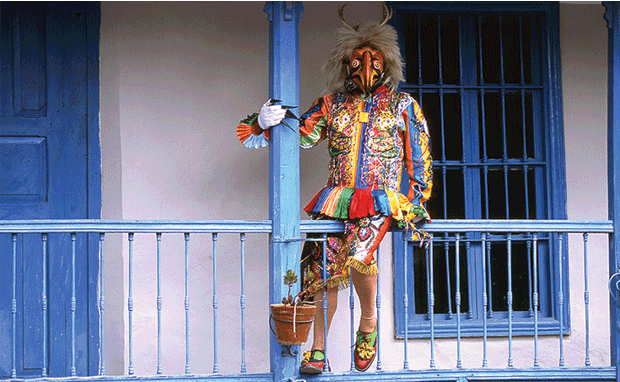|
Jeremy Hunter has spent 35 years documenting ancient
rituals and festivals in 60 countries. Here is a small selection of
photographs that will appear as part of Let's Celebrate 365, a major
retrospective of his work.
|
|
 |
|
For centuries, the peoples of the highlands of Papa
New Guinea have fought over land, women and pigs. Sorcery and Bigmanship
are some of the weapons are used to fight ward off invaders – clans
would paint their bodies with clay and create fearsome masks as part of
their psychological warfare against the invasion of their territory by
other clans. This is a mudman from a village in the Wahgi Valley, near
the town of Mount Hagen.
|
|
 |
|
Sing-sings in Papua New Guinea form an important part of cultural life
as they represent an opportunity for the clans to express their tribal
solidarity. I saw the black snake dance performed by the Apenda clan
when they attended a sing-sing in Leh, near Morobe.
|
|
 |
|
The Mursi - a tribe without chiefs or leaders - occupy land in southern
Ethiopia between the Omo river and its tributary the Mago. The
distinctive trait of the Mursi is the labial plate worn by the women.
Anthropological studies suggest that the plates are an expression of
social status. The plates are removed to eat and drink but never when
Mursi men are close by. This woman’s plate, fired from clay, is 14 cm in
diameter - the size of a large saucer.
|
|
 |
|
The Horn Dance is an ancient fertility celebration whose festival date
is determined by a quirky formula: it is always celebrated on the Monday
following the first Sunday after 4 September. The English folk dance is
believed to be part of a pagan hunting ritual with origins that can be
traced back to Saxon times; it was first performed at the Berthelmy Fair
near Burton-on-Trent in 1226. The dancers carry around the lanes of
rural Staffordshire six pairs of enormous reindeer horns, which have
been carbon dated to 1065.
|
|
 |
|
In the monastic town of Labrang, in the autonomous region of East Tibet,
life and local customs can still be witnessed as they were some 500
years ago. During the Great Monlam festival, which heralds the start of
the Tibetan New Year, the entire monkhood assemble in front of the
Living Buddha, who is presented with hundreds of spiritual messages. The
reading of these takes several hours, during which the monks must remain
squatting motionless on the ground, regardless of the freezing
conditions. On this day of blizzards, the temperature plummeted to -27C.
|
|
 |
|
The Alphorn festival is celebrated annually in Nesselwang, Bavaria,
where it seems that every Alphorn-ist in the world has gathered to
perform in the final harmonic ensemble. The 2,000-year-old alphorn makes
a unique melifluous sound that through the centuries has been used for
sending signals across alpine valleys. |
|

|
|
In Oristano, Sardinia, Paganism and Catholicism have developed side by
side. Every February, the finest horseman of the region is elected
Componidori for La Sartiglia festival. For one day, he is no longer a
man; he becomes an androgynous masked god-horseman. His equestrian
skills are put to the ultimate test and if, during the course of the
day, the god-horseman falls from his horse, the fortune of the entire
region will be in jeopardy for the coming 12 months. |
|

|
|
In Peru, La Virgen del Carmen is known as the Earth Mother, and every
July in Paucartambo, a remote town at an altitude of almost 3,000 metres
on the lower slopes of the Andes, the townsfolk celebrate her life with
a huge fiesta that has been taking place since the 17th century.
Throughout the three-day festival, the image of the virgen is paraded
through the streets while bizarre Pagan animals (like this bird-like
creature) attempt to attract her attention. |
|

|
|
Lincolnshire's Straw Bear festival takes place every January in
Whittlesea. After twelfth night in times past, it was the custom to
dress one of the ploughmen in straw and call him a "straw bear". A
newspaper of 1882 reported that “He was then taken around the town to
entertain by his frantic and clumsy gestures the good folk who had on
the previous day subscribed to the rustics a spread of beer, tobacco and
beef.” Today, the bear is taken on a lead around the village and at the
end of two days of festivities, ritually burnt, leaving the way open for
a new bear to be created for the next season’s harvest. |